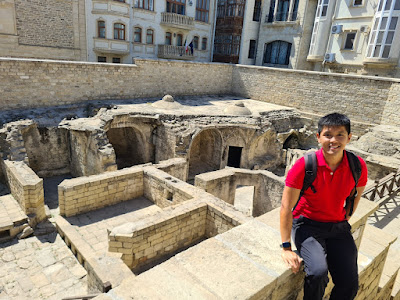AZE: Palace of the Shirvanshahs
Zamkovskaya Side-Street, Icherisheher, Baku, Azerbaijan
Daily: 10.00am - 6.00pm
Erected in the 15th century within Icherisheher, Palace of the Shirvanshahs is described by UNESCO as "one of the pearls of Azerbaijan's architecture". Shirvan is a historical region in eastern Caucasus, covering a sizeable area from the western shores of the Caspian Sea in the east to the Kura River in the west. The rulers of Shirvan were given the title Shirvanshahs.
---
AZE: Palace of the Shirvanshahs <YOU ARE HERE!>
---
As adult foreigners, my BFF and I paid AZN 15.00 (~S$11.75) each to enter the palace complex.
 |
| There were originally 52 rooms: 27 on the first floor and 25 on the second floor. |
 |
| Line of succession of the Shirvanshahs, I suppose? |
My expectation was to see the various rooms within the palace when it was used as a dwelling place, such as bedrooms, bathrooms and kitchen, but it turns out that the main building is used to display a collection of artifacts instead.
 |
| Having played so many video games since young, I believe the curved sword is called scimitar. |
 |
| I wonder if there's a special significance of the number 40. |
 |
| That's a lovely decorative plate, don't you think? |
 |
| Ibrahim I, the 33rd Shirvanshah, transferred the capital from Shemakha to Baku following a devastating earthquake. |
After the conquest of Baku in 1501 by the Safavid Empire, one of the greatest Iranian empires, the palace fell into ruins. It was during the existence of the Azerbaijan Democratic Republic from 1918 that a number of measures were taken to study, as well as repair the architectural monuments.
 |
| Such an ornate water bottle! |
 |
| Kufic is the oldest calligraphic form of the various Arabic scripts. |
 |
| "Baku, The Capital of Oil" by J. M. Mufitzade |
We eventually reached the last room, which showcases a lovely model of the walled city.
 |
| I'm so much in love with the symmetry of the ceiling. |
There are photos of Heydar Aliyev, the third president of Azerbaijan, in the same room. Though long accused of forming an autocratic system in the country and also violating human rights, his cult of personality has persisted since the time he came to power in 1993 and even after his death in 2003.
The palace complex comprises three courtyards. All the structures were built with local limestone.
 |
| Originally, there were 9 buildings within the complex. |
 |
| At the point of writing, the latest restoration was completed in 2006. |
There are quite a number of stone slabs with Arabic writings.
 |
| They are fragments of the stone frieze of Sabayil Fortress. |
Situated at the centre of the middle courtyard is a mausoleum named after Seyid Yahya Bakuvi, a local thinker and philosopher, who is buried in it.
 |
| Be careful of your head! |
 |
| The mausoleum was constructed in 1457. |
Toilets can only be found near Murad's Gate that was built in 1585.
There's a mosque built in 1441.
 |
| There are two praying halls inside the mosque. Shown here is the bigger one. |
There's a tomb built for Shirvan Khalilullah I's family.
 |
| It was initially used as a place of burial of the Shirvan's mother and his son aged 6. |
Divankhana is a twelve-headed dome with an octagonal rotor.
The palace is featured on the obverse of the AZN 10,000 (~S$7,814.20) banknotes of 1994 to 2006, and on the AZN 10 (~S$7.80) banknotes issued since 2006.















































Comments
Post a Comment